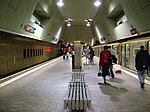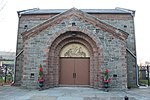Grace Episcopal Church Complex (Queens)

Grace Episcopal Church Complex is a historic Episcopal church complex at 155-15 Jamaica Avenue in Jamaica, Queens, New York City, in U.S. state of New York. The complex includes the church, parish house, and cemetery. The church was built between 1861 and 1862. It is constructed of rough-cut sandstone and features a steeply pitched roof and tall, sharp spire in the Gothic Revival style. A chancel, designed by Cady, Berg & See, was added at the rear of the church in 1901-1902. The parish house, known as Grace Memorial House, was built in 1912. It is three-story brick building in the Tudor Revival style. The surrounding cemetery includes burials dating to 1734, when the church located at this site. Notable interments include Rufus King (1755–1827), Charles King (1789–1867) and William Duer (1743–1799).
Excerpt from the Wikipedia article Grace Episcopal Church Complex (Queens) (License: CC BY-SA 3.0, Authors, Images).Grace Episcopal Church Complex (Queens)
Grace Court, New York Queens
Geographical coordinates (GPS) Address Nearby Places Show on map
Geographical coordinates (GPS)
| Latitude | Longitude |
|---|---|
| N 40.703888888889 ° | E -73.801944444444 ° |
Address
Grace Court 90-24
11432 New York, Queens
New York, United States
Open on Google Maps








